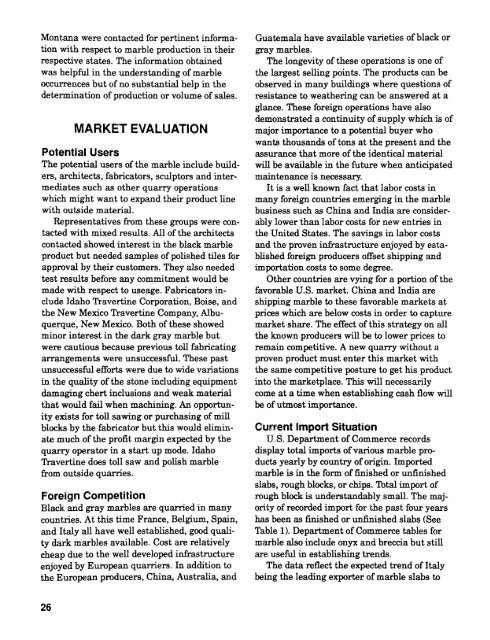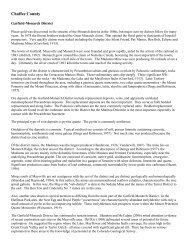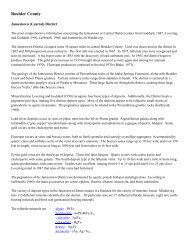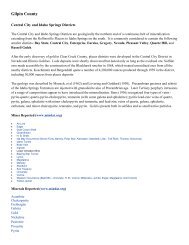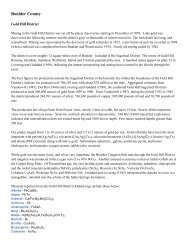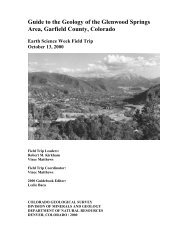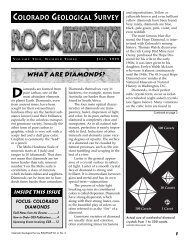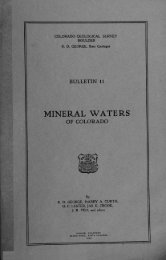Marble - Colorado Geological Survey
Marble - Colorado Geological Survey
Marble - Colorado Geological Survey
You also want an ePaper? Increase the reach of your titles
YUMPU automatically turns print PDFs into web optimized ePapers that Google loves.
Montana were contacted for pertinent information<br />
with respect to marble production in their<br />
respective states. The information obtained<br />
was helpful in the understanding of marble<br />
occurrences but of no substantial help in the<br />
determination of production or volume of sales.<br />
MARKET EVALUATION<br />
Potential Users<br />
The potential users of the marble include builders,<br />
architects, fabricators, sculptors and intermediates<br />
such as other quarry operations<br />
which might want to expand their product line<br />
with outside material.<br />
Representatives from these groups were contacted<br />
with mixed results. All of the architects<br />
contacted showed interest in the black marble<br />
product but needed samples of polished tiles for<br />
approval by their customers. They also needed<br />
test results before any commitment would be<br />
made with respect to useage. Fabricators include<br />
Idaho Travertine Corporation, Boise, and<br />
the New Mexico Travertine Company, Albuquerque,<br />
New Mexico. Both of these showed<br />
minor interest in the dark gray marble but<br />
were cautious because previous toll fabricating<br />
arrangements were unsuccessful. These past<br />
unsuccessful efforts were due to wide variations<br />
in the quality of the stone including equipment<br />
damaging chert inclusions and weak material<br />
that would fail when machining. An opportunity<br />
exists for toll sawing or purchasing of mill<br />
blocks by the fabricator but this would eliminate<br />
much of the profit margin expected by the<br />
quarry operator in a start up mode. Idaho<br />
Travertine does toll saw and polish marble<br />
from outside quarries.<br />
Foreign Competition<br />
Black and gray marbles are quarried in many<br />
countries. At this time France, Belgium, Spain,<br />
and Italy all have well established, good quality<br />
dark marbles available. Cost are relatively<br />
cheap due to the well developed infrastructure<br />
enjoyed by European quarriers. In addition to<br />
the European producers, China, Australia, and<br />
26<br />
Guatemala have available varieties of black or<br />
gray marbles.<br />
The longevity of these operations is one of<br />
the largest selling points. The products can be<br />
observed in many buildings where questions of<br />
resistance to weathering can be answered at a<br />
glance. These foreign operations have also<br />
demonstrated a continuity of supply which is of<br />
major importance to a potential buyer who<br />
wants thousands of tons at the present and the<br />
assurance that more of the identical material<br />
will be available in the future when anticipated<br />
maintenance is necessary.<br />
It is a well known fact that labor costs in<br />
many foreign countries emerging in the marble<br />
business such as China and India are considerably<br />
lower than labor costs for new entries in<br />
the United States. The savings in labor costs<br />
and the proven infrastructure enjoyed by established<br />
foreign producers offset shipping and<br />
importation costs to some degree.<br />
Other countries are vying for a portion of the<br />
favorable U.S. market. China and India are<br />
shipping marble to these favorable markets at<br />
prices which are below costs in order to capture<br />
market share. The effect of this strategy on all<br />
the known producers will be to lower prices to<br />
remain competitive. A new quarry without a<br />
proven product must enter this market with<br />
the same competitive posture to get his product<br />
into the marketplace. This will necessarily<br />
come at a time when establishing cash flow will<br />
be of utmost importance.<br />
Current Import Situation<br />
U.S. Department of Commerce records<br />
display total imports of various marble products<br />
yearly by country of origin. Imported<br />
marble is in the form of finished or unfinished<br />
slabs, rough blocks, or chips. Total import of<br />
rough block is understandably small. The majority<br />
of recorded import for the past four years<br />
has been as finished or unfinished slabs (See<br />
Table 1). Department of Commerce tables for<br />
marble also include onyx and breccia but still<br />
are useful in establishing trends.<br />
The data reflect the expected trend of Italy<br />
being the leading exporter of marble slabs to


